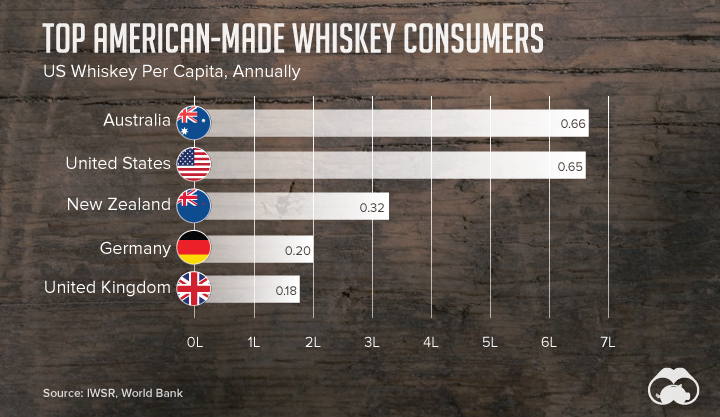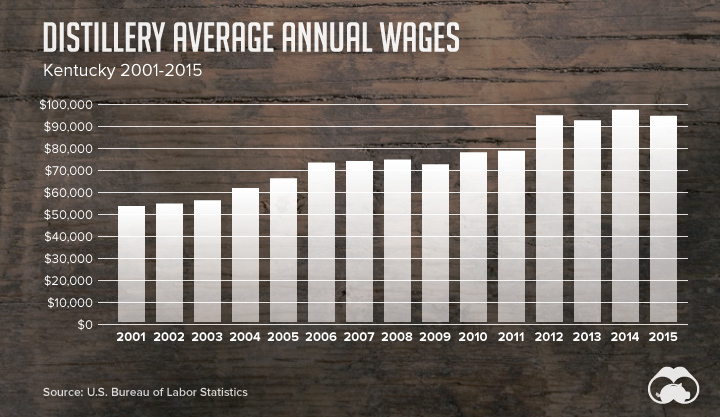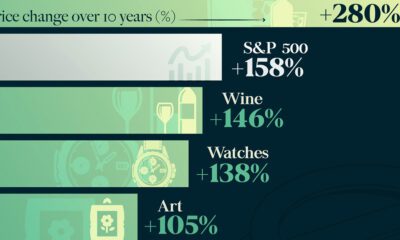Misc
America’s Bourbon Boom
Bourbon, America’s only homegrown spirit, holds a special place in the country’s history. In fact, George Washington ran the nation’s largest distillery in the early 1800s.
Today’s infographic comes from WebstaurantStore, and it digs into whiskey’s history, production, market shares, and more. Even seasoned fans will likely pick up some new facts to share over that next dram of bourbon.

American whiskey is experiencing an impressive resurgence, but the road to the current bourbon boom hasn’t always been smooth.
Grandpa’s Drink
In the 1960s, white spirits such as vodka were experiencing a big boost in sales. Inspired by James Bond, younger consumers were imbibing martinis and mixed drinks like highballs and Bloody Marys. As a result, American whiskey brands were beginning to see their market shares erode.
In an effort to reinvigorate sales, distillers shifted down-market to create lighter, cheaper whiskeys that were designed for cocktail mixing. Bourbon’s image – and bottom line – took a huge hit as young consumers saw the spirit as “grandpa’s drink”.
Back from the dead
There were a few factors that brought bourbon back into the mainstream.
First, the spirit got a big boost from Japanese companies. Both Kirin and Suntory are heavily invested in bourbon production, and their wide reach helped spark global demand, particularly in Australia and New Zealand:

American Whiskey has also received a boost from hipster culture and the popularity of shows such as Mad Men and House of Cards, where heavyweight characters are fans of the spirit. Ultra-premium and craft batches are generating a lot of excitement, and there is still plenty of room for the category to continue growing.
In short, bourbon is having a moment.
Kentucky is winning big
Thanks to surging demand for American whiskey domestically and abroad, Kentucky’s economy is also profiting from the bourbon boom. The distilling industry now has an annual economic impact of $8.5 billion. As well, the industry is in the midst of a $1.2 billion construction boom as distillers reinvest capital into expansion projects (fueled by recent tax cuts).
The bourbon boom is benefiting employees as well. Average salaries in the industry have nearly doubled since 2001:

The Future
With brisk demand and expanding production, the bourbon boom is showing no signs of slowing down. For investors looking to capitalize on the trend, there’s even a whiskey-oriented ETF: WSKY.
This truly is the golden age of bourbon
– Eric Gregory, President, Kentucky Distillers’ Association
Maps
The Largest Earthquakes in the New York Area (1970-2024)
The earthquake that shook buildings across New York in April 2024 was the third-largest quake in the Northeast U.S. over the past 50 years.

The Largest Earthquakes in the New York Area
This was originally posted on our Voronoi app. Download the app for free on Apple or Android and discover incredible data-driven charts from a variety of trusted sources.
The 4.8 magnitude earthquake that shook buildings across New York on Friday, April 5th, 2024 was the third-largest quake in the U.S. Northeast area over the past 50 years.
In this map, we illustrate earthquakes with a magnitude of 4.0 or greater recorded in the Northeastern U.S. since 1970, according to the United States Geological Survey (USGS).
Shallow Quakes and Older Buildings
The earthquake that struck the U.S. Northeast in April 2024 was felt by millions of people from Washington, D.C., to north of Boston. It even caused a full ground stop at Newark Airport.
The quake, occurring just 5 km beneath the Earth’s surface, was considered shallow, which is what contributed to more intense shaking at the surface.
According to the USGS, rocks in the eastern U.S. are significantly older, denser, and harder than those on the western side, compressed by time. This makes them more efficient conduits for seismic energy. Additionally, buildings in the Northeast tend to be older and may not adhere to the latest earthquake codes.
Despite disrupting work and school life, the earthquake was considered minor, according to the Michigan Technological University magnitude scale:
| Magnitude | Earthquake Effects | Estimated Number Each Year |
|---|---|---|
| 2.5 or less | Usually not felt, but can be recorded by seismograph. | Millions |
| 2.5 to 5.4 | Often felt, but only causes minor damage. | 500,000 |
| 5.5 to 6.0 | Slight damage to buildings and other structures. | 350 |
| 6.1 to 6.9 | May cause a lot of damage in very populated areas. | 100 |
| 7.0 to 7.9 | Major earthquake. Serious damage. | 10-15 |
| 8.0 or greater | Great earthquake. Can totally destroy communities near the epicenter. | One every year or two |
The largest earthquake felt in the area over the past 50 years was a 5.3 magnitude quake that occurred in Au Sable Forks, New York, in 2002. It damaged houses and cracked roads in a remote corner of the Adirondack Mountains, but caused no injuries.
| Date | Magnitude | Location | State |
|---|---|---|---|
| April 20, 2002 | 5.3 | Au Sable Forks | New York |
| October 7, 1983 | 5.1 | Newcomb | New York |
| April 5, 2024 | 4.8 | Whitehouse Station | New Jersey |
| October 16, 2012 | 4.7 | Hollis Center | Maine |
| January 16, 1994 | 4.6 | Sinking Spring | Pennsylvania |
| January 19, 1982 | 4.5 | Sanbornton | New Hampshire |
| September 25, 1998 | 4.5 | Adamsville | Pennsylvania |
| June 9, 1975 | 4.2 | Altona | New York |
| May 29, 1983 | 4.2 | Peru | Maine |
| April 23, 1984 | 4.2 | Conestoga | Pennsylvania |
| January 16, 1994 | 4.2 | Sinking Spring | Pennsylvania |
| November 3, 1975 | 4 | Long Lake | New York |
| June 17, 1991 | 4 | Worcester | New York |
The largest earthquake in U.S. history, however, was the 1964 Good Friday quake in Alaska, measuring 9.2 magnitude and killing 131 people.
-

 Misc2 weeks ago
Misc2 weeks agoTesla Is Once Again the World’s Best-Selling EV Company
-

 AI1 week ago
AI1 week agoThe Stock Performance of U.S. Chipmakers So Far in 2024
-

 Misc1 week ago
Misc1 week agoAlmost Every EV Stock is Down After Q1 2024
-

 Money2 weeks ago
Money2 weeks agoWhere Does One U.S. Tax Dollar Go?
-

 Green2 weeks ago
Green2 weeks agoRanked: Top Countries by Total Forest Loss Since 2001
-

 Real Estate2 weeks ago
Real Estate2 weeks agoVisualizing America’s Shortage of Affordable Homes
-

 Maps2 weeks ago
Maps2 weeks agoMapped: Average Wages Across Europe
-

 Mining2 weeks ago
Mining2 weeks agoCharted: The Value Gap Between the Gold Price and Gold Miners















